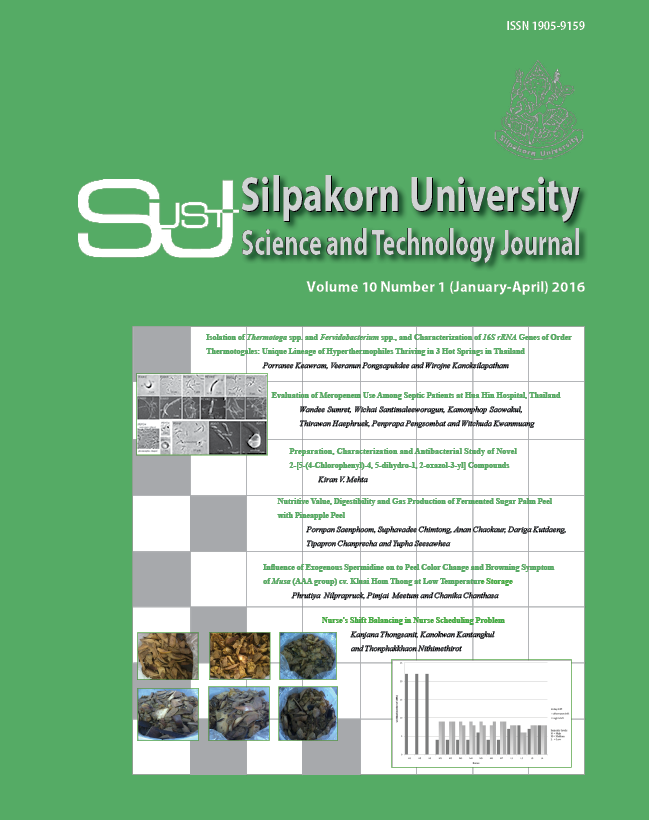Influence of Exogenous Spermidine on to Peel Color Change and Browning Symptom of Musa (AAA group) cv. Kluai Hom Thong at Low Temperature Storage
Main Article Content
Abstract
Musa (AAA Group) cv. Kluai Hom Thong is popular and widely consumed fruits in Thailand and overseas. This experiment showed an influence of spermidine (SPD) on change of peel color and browning in banana. Ripe bananas were soaked with 0, 0.2, 0.5 and 2.0 mM and then stored at 10 oC, 85±5 %RH. Bananas, treated with 0.5 and 2.0 mM SPD, showed alteration of biochemical changes such as color, ripping and enzymatic browning reaction. Biochemical changes included chlorophyll, carotenoid, phenolic compounds, as well as polyphenol oxidase and peroxidase activities which increased during storage. Bananas, treated with SPD at 0.5 and 2.0 mM, exhibited a reduction in an accumulation of phenolic compounds, polyphenol oxidase and peroxidase activities, comparing with the non-treated SPD samples.
Downloads
Article Details
References
Biasi, R., Bagni, N., and Costa,G.(1988). Endogenous polyamines in apple and their relationship to fruit set and fruit growth. Physiologia Plantarum, 73: 201-205.
Bradford, M. M. (1976). A rapid and sensitive method for the quantitation of microgram quantitives of protein utilizing the principle of proteindye binding. Analytical Biochemistry, 72: 248-254.
Chen, T., Xu, Y., Wang, J., Wang, Z., Yang, J., and Zhang, J. (2013). Polyamines and ethylene interact in rice grains in response to soil drying during grain filling. Journal of Experimental Botany, 64(8): 2523-2538.
Cohen, S. S. (1998). A guide to the polyamines, New York: Oxford University Press.
De Oliveira Lima, L. C., Chitara, A. B., Chitara, M. I. F., and Silva, E. B. (1999). Enzymatic activities changes in spongy tissue: A physiological ripening disorder of ‘Tommy Atkins’ mango. ISHS Acta Horticulturae, 485: 255-285.
Flores, H. E., Protacio, C. M., and Signs, M. W. (1989). Primary and secondary metabolism of polyamines in plant. In Recent Advance in Phytochemistry (Poulton, J.E., Romeo, J.T. and Conn, E.E., eds.) pp. 329-393. Plant Nitrogen Metabolism. New York: Pienum Press.
Flurkey, W. H. and Jen, J. J. (1978). Peroxidase and pholyphenol oxidase activities in developing peaches. Journal of Food Science, 48: 403-405.
Gonzalez-Aguilar, G. A., Gayosso, L., Cruza, R., Fortiz, J., Baez, R., and Wang, C.Y. (2000). Polyamines induced by hot water treatments reduce chilling injury and decay in pepper fruit. Postharvest Biology and Technology, 18: 19–26.
Kerbel, E. (2004). Banana and Plaintain, Agriculture Handbook Number 66, The Commercial Storage of Fruits, Vegetables, and Florist and Nursery Stocks, [Online URL: www.ba.ars.usda.gov/hb66/contents.htm] accessed on April, 2004.
Ketsa, S.and Atantee, S.(1998). Phenolics, lignin, peroxidase activity and increased firmness of damaged pericarp of mangosteen fruit after impact. Postharvest Biology and Technology, 14: 117-124.
Kusano, T., Berberich, T., Tateda, C., and Takahashi, Y. (2008). Polyamines: essential factor s for growth and survival. Planta, 228: 367-381.
Kushad, M. M. (1998). Changes in polyamine levels in relationship to the double-sigmoidal growth curve of peaches. Journal of the American Society for Horticultural Science, 129: 950-955.
Liu, J., Nada, K., Pang, X., Honda, C., Kitashiba, H., and Moriguchi, T. (2006). Role of polyamines in peach fruit development and storage. Tree Physiology, 26: 791-798.
Malik, A. U. and Singh, Z. (2005). Pre-storage application of polyamines improves shelf life and fruit quality of mango. The Journal of Horticultural Science and Biotechnology, 80: 363-369.
Mattoo, A. K. and Handa, A. K. (2008). Higher polyamines restore and enhance metabolic memory in ripening fruit. Plant Science, 174: 386–393.
Mayer, A. M. (1987). Polyphenol oxidases in plants-recent progress. Phytochemistry, 26: 11-20.
Rodov, V., Ben-Yehoshua, S., Albagli, R., and Fang, D. Q. (1995). Reducing chilling Injury and decay of stored citrus fruit by hot water dips. Postharvest Biology and Technology, 5: 119–127.
Singh, Z. and Malik, A. U. (2004). Endogenous Free Polyamines of mangos in relation to development and ripening. Journal of the American Society for Horticultural Science, 129(3): 280-286.
Vamos-Vigyazo, L. (1981). Polyphenol oxidase and peroxidase in fruits and vegetables. Critical Reviews in Food Science and Nutrition, 15:49-127.
Walker, J. R. L. and Ferrar, P. H. (1998). Diphenol oxidase, enzyme-catalysed browning and plant disease resistance. Biotechnology & Genetic Engineering Reviews, 15: 457-498.
Zhang, W., Jiang, B., Li, W., Song, H., Yu, Y., and Chen, J. (2009). Polyamines enhance chilling tolerance of cucumber (Cucumis sativus L.) through modulating antioxidative system. Scientia Horticulturae, 122:200–208.
Ziosi, V., Scaramagli, S., Bregoli, A. M., Biondi, S., and Torrigiani, P. (2003). Peach (Pruns persica L.) fruit growth and ripening: transcript levels and activity of polyamine biosynthetic enzymes in the mesoca. Journal of Plant Physiology, 160: 1109-1115.

